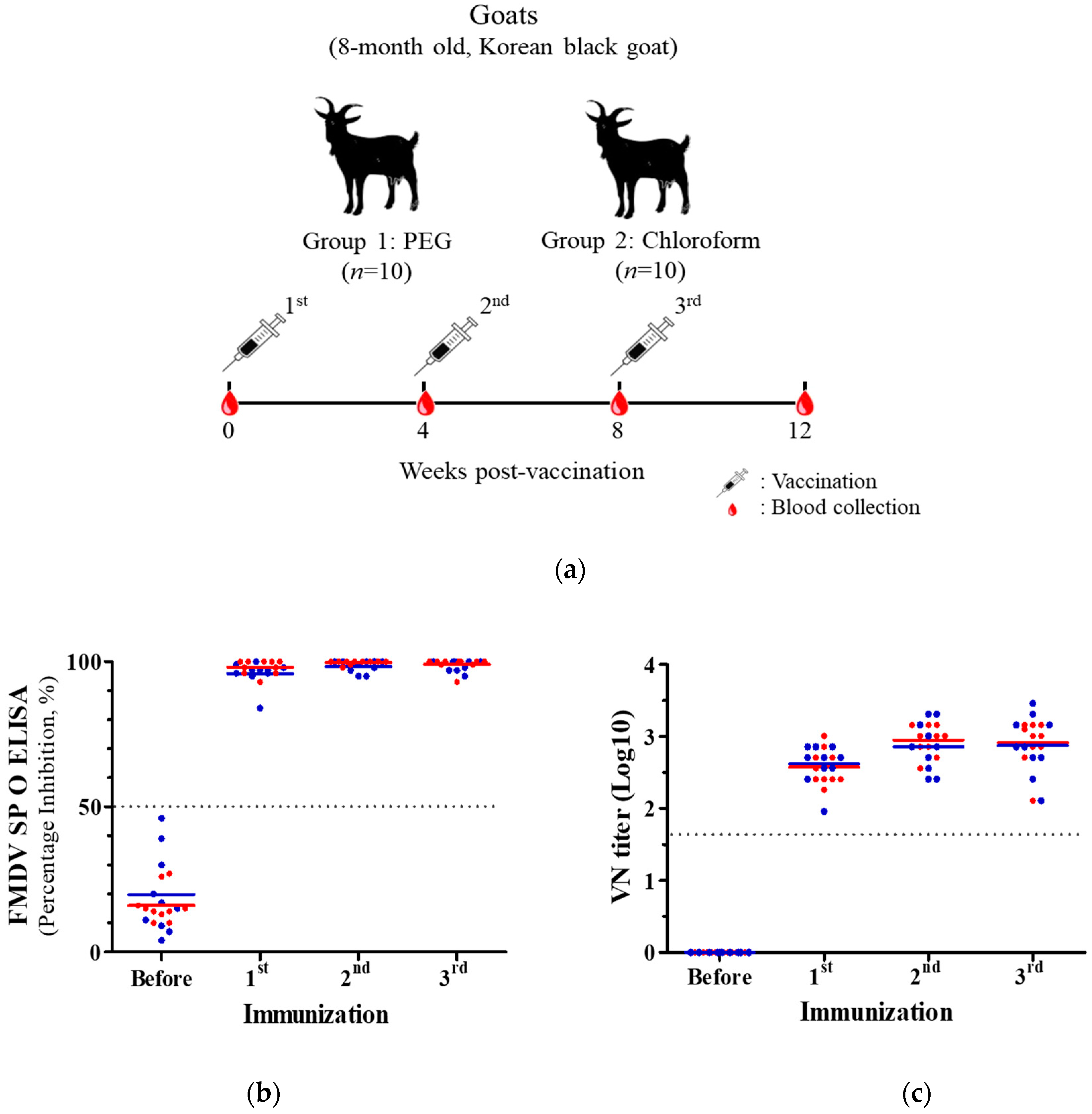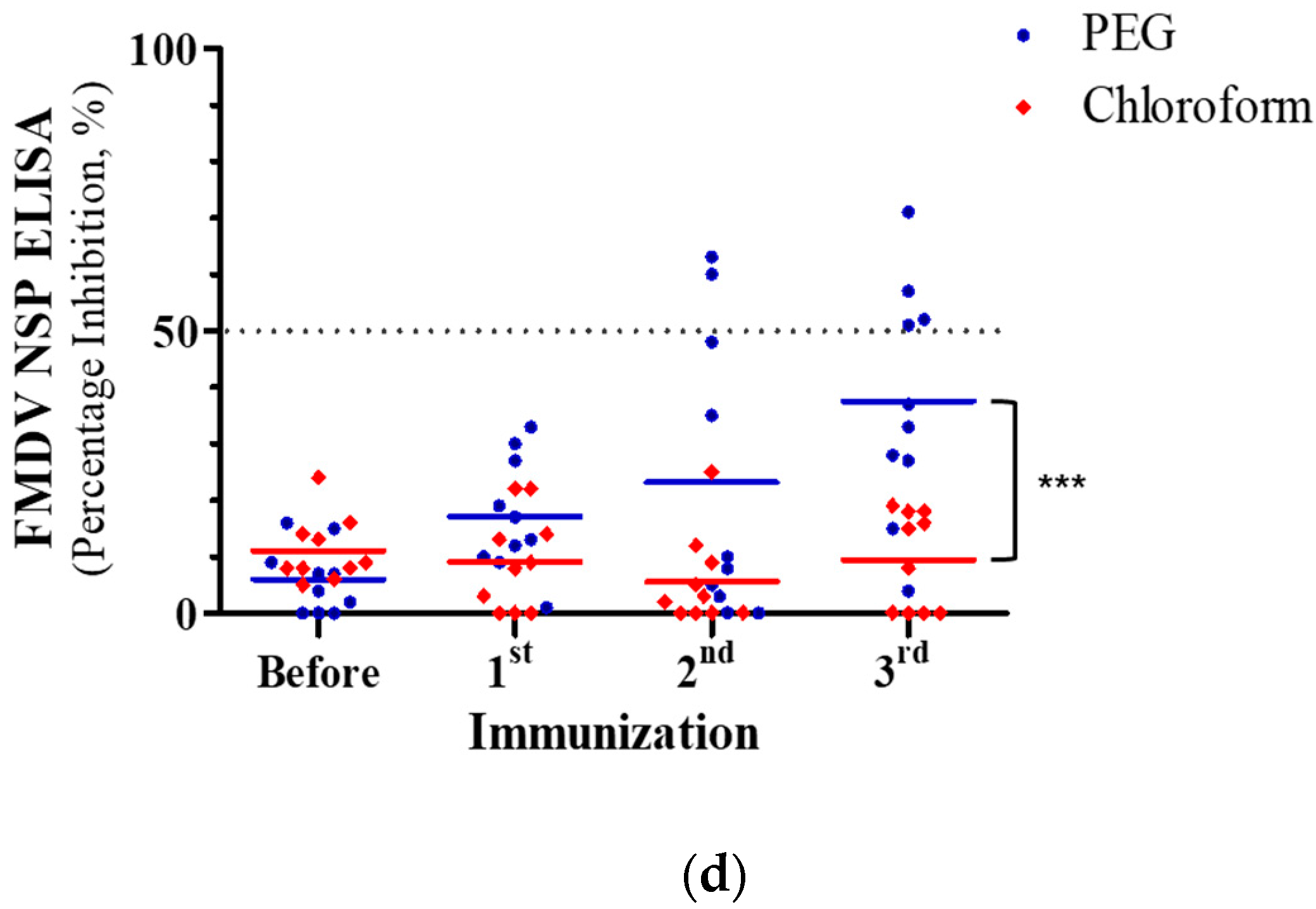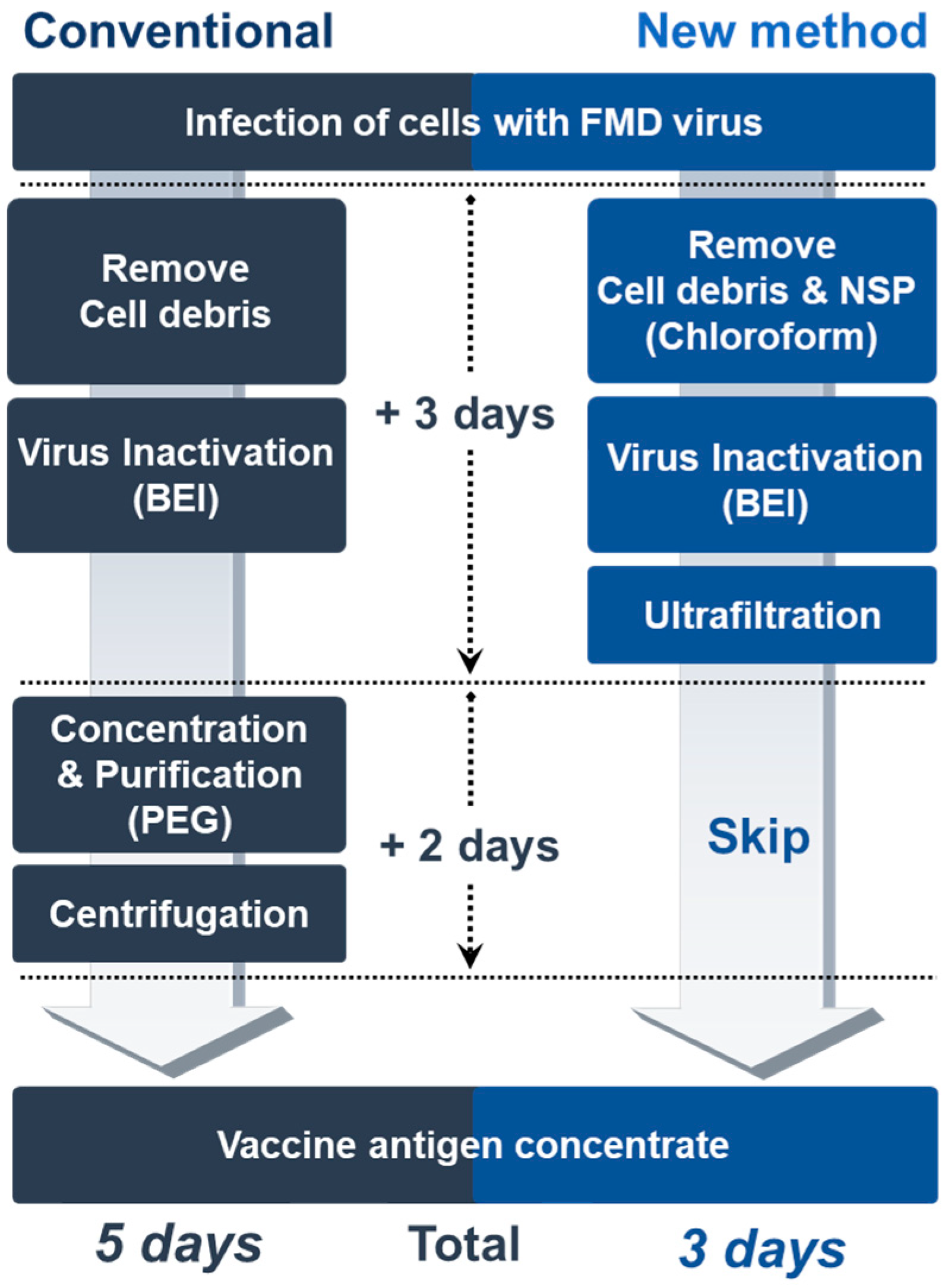Efficient Removal of Non-Structural Protein Using Chloroform for Foot-and-Mouth Disease Vaccine Production
Abstract
1. Introduction
2. Materials and Methods
2.1. Cells and Viruses
2.2. Chloroform Treatment
2.3. Western Blot Analysis
2.4. Virus Titration
2.5. Preparation of Vaccines
2.6. Immunization of Animals
2.7. ELISA
2.8. Virus Neutralization Test
2.9. Statistical Analysis
3. Results
3.1. Effect of Chloroform Treatment on FMDV SP and NSP
3.2. Comparison of NSPs in FMD Vaccine Antigens Prepared by PEG and Chloroform Treatment
3.3. Antibody Responses Elicited by Immunizations With PEG- and Chloroform-Treated FMD Vaccines
4. Discussion
5. Conclusions
Author Contributions
Funding
Conflicts of Interest
References
- Mason, P.W.; Grubman, M.J.; Baxt, B. Molecular basis of pathogenesis of FMDV. Virus Res. 2003, 91, 9–32. [Google Scholar] [CrossRef]
- Murphy, F.A.; Gibbs, E.P.J.; Horzinek, M.C.; Studdert, M.J. Veterinary Virology; Elsevier: Amsterdam, The Netherlands, 1999. [Google Scholar]
- Grubman, M.J.; Baxt, B. Foot-and-mouth disease. Clin. Microbiol. Rev. 2004, 17, 465–493. [Google Scholar] [CrossRef] [PubMed]
- Mignaqui, A.C.; Ruiz, V.; Durocher, Y.; Wigdorovitz, A. Advances in novel vaccines for foot and mouth disease: Focus on recombinant empty capsids. Crit. Rev. Biotechnol. 2019, 39, 306–320. [Google Scholar] [CrossRef] [PubMed]
- International Committee, Biological Standards Commission, International Office of Epizootics. Manual of Diagnostic Tests and Vaccines for Terrestrial Animals: Mammals, Birds, and Bees; Renouf Publishing Co. Ltd.: Ottawa, ON, Canada, 2018; Available online: https://www.oie.int/fileadmin/Home/eng/Health_standards/tahm/3.01.08_FMD.pdf (accessed on 26 August 2020).
- Wagner, G.G.; Card, J.L.; Cowan, K.M. Immunochemical studies of foot-and-mouth disease. VII. Characterization of foot-and-mouth disease virus concentrated by polyethylene glycol precipitation. Arch. Fur Die Gesamte Virusforsch. 1970, 30, 343–352. [Google Scholar] [CrossRef] [PubMed]
- Bergmann, I.E.; Neitzert, E.; Malirat, V.; de Mendonca Campos, R.; Pulga, M.; Muratovik, R.; Quintino, D.; Morgados, J.C.; Oliveira, M.; de Lucca Neto, D. Development of an inhibition ELISA test for the detection of non-capsid polyprotein 3ABC in viral suspensions destined for inactivated foot-and-mouth disease vaccines. Dev. Biol. 2006, 126, 241–250. [Google Scholar]
- Robinson, L.; Knight-Jones, T.J.D.; Charleston, B.; Rodriguez, L.L.; Gay, C.G.; Sumption, K.J.; Vosloo, W. Global Foot-and-Mouth Disease Research Update and Gap Analysis: 3-Vaccines. Transbound. Emerg. Dis. 2016, 63, 30–41. [Google Scholar] [CrossRef] [PubMed]
- Lee, F.; Jong, M.-H.; Yang, D.-W. Presence of antibodies to non-structural proteins of foot-and-mouth disease virus in repeatedly vaccinated cattle. Vet. Microbiol. 2006, 115, 14–20. [Google Scholar] [CrossRef] [PubMed]
- Lee, E.G.; Park, S.Y.; Tark, D.S.; Lee, H.S.; Ko, Y.J.; Kim, Y.G.; Park, S.Y.; Kim, C.S.; Ryu, K.H.; Lee, M.H.; et al. Novel BHK-21 Cell Line Available for Suspension Culture in Serum-Free Medium and Method for Foot-and-Mouth Disease Vaccine Production Using the Same. KR101812223B1, 27 December 2017. Available online: https://patents.google.com/patent/KR101812223B1/en (accessed on 26 August 2020).
- Karber, G. Beitrag zur kollektiven behandlung pharmakologischer reihenversuche. Arch. Fur Exp. Pathol. Phamakologie 1931, 162, 480–483. [Google Scholar] [CrossRef]
- Colling, A.; Morrissy, C.; Barr, J.; Meehan, G.; Wright, L.; Goff, W.; Gleeson, L.J.; van der Heide, B.; Riddell, S.; Yu, M.; et al. Development and validation of a 3ABC antibody ELISA in Australia for foot and mouth disease. Aust. Vet. J. 2014, 92, 192–199. [Google Scholar] [CrossRef] [PubMed]
- García-Briones, M.; Rosas, M.F.; González-Magaldi, M.; Martín-Acebes, M.A.; Sobrino, F.; Armas-Portela, R. Differential distribution of non-structural proteins of foot-and-mouth disease virus in BHK-21 cells. Virology 2006, 349, 409–421. [Google Scholar] [CrossRef] [PubMed]
- Frew, P.M.; Mulligan, M.J.; Hou, S.I.; Chan, K.; del Rio, C. Time will tell: Community acceptability of HIV vaccine research before and after the “Step Study” vaccine discontinuation. Open Access J. Clin. Trials 2010, 2010, 149–156. [Google Scholar] [CrossRef] [PubMed]
- Behura, M.; Mohapatra, J.K.; Pandey, L.K.; Das, B.; Bhatt, M.; Subramaniam, S.; Pattnaik, B. The carboxy-terminal half of nonstructural protein 3A is not essential for foot-and-mouth disease virus replication in cultured cell lines. Arch. Virol. 2016, 161, 1295–1305. [Google Scholar] [CrossRef] [PubMed]
- Park, J.-N.; Lee, S.-Y.; Chu, J.-Q.; Lee, Y.-J.; Kim, R.-H.; Lee, K.-N.; Kim, S.-M.; Tark, D.-S.; Kim, B.; Park, J.-H.J.V. Protection to homologous and heterologous challenge in pigs immunized with vaccine against foot-and-mouth disease type O caused an epidemic in East Asia during 2010/2011. Vaccine 2014, 32, 1882–1889. [Google Scholar] [CrossRef] [PubMed]
- He, C.; Wang, H.; Wei, H.; Yan, Y.; Zhao, T.; Hu, X.; Luo, P.; Wang, L.; Yu, Y. A recombinant truncated FMDV 3AB protein used to better distinguish between infected and vaccinated cattle. Vaccine 2010, 28, 3435–3439. [Google Scholar] [CrossRef] [PubMed]
- International Committee, Biological Standards Commission, International Office of Epizootics. Manual of Diagnostic Tests and Vaccines for Terrestrial Animals: Mammals, Birds, and Bees; Renouf Publishing Co. Ltd.: Ottawa, ON, Canada, 2012; Available online: https://www.oie.int/doc/ged/D12008.pdf (accessed on 26 August 2020).
- Feng, X.; Ma, J.-W.; Sun, S.-Q.; Guo, H.-C.; Yang, Y.-M.; Jin, Y.; Zhou, G.-Q.; He, J.-J.; Guo, J.-H.; Qi, S.-y.; et al. Quantitative detection of the foot-and-mouth disease virus serotype O 146S antigen for vaccine production using a double-antibody sandwich ELISA and nonlinear standard curves. PLoS ONE 2016, 11, e0149569. [Google Scholar] [CrossRef] [PubMed]
- Lombard, M.; Füssel, A.E. Antigen and vaccine banks: Technical requirements and the role of the european antigen bank in emergency foot and mouth disease vaccination. Rev. Sci. Tech. 2007, 26, 117–134. [Google Scholar] [CrossRef] [PubMed]
- Li, H.; Yang, Y.; Zhang, Y.; Zhang, S.; Zhao, Q.; Zhu, Y.; Zou, X.; Yu, M.; Ma, G.; Su, Z. A hydrophobic interaction chromatography strategy for purification of inactivated foot-and-mouth disease virus. Protein Expr. Purif. 2015, 113, 23–29. [Google Scholar] [CrossRef] [PubMed]
- Du, P.; Sun, S.; Dong, J.; Zhi, X.; Chang, Y.; Teng, Z.; Guo, H.; Liu, Z.J. Purification of foot-and-mouth disease virus by heparin as ligand for certain strains. J. Chromatogr. B Anal. Technol. Biomed. Life Sci. 2017, 1049, 16–23. [Google Scholar] [CrossRef] [PubMed]
- Biswal, J.K.; Bisht, P.; Subramaniam, S.; Ranjan, R.; Sharma, G.K.; Pattnaik, B.J.B. Engineering foot-and-mouth disease virus serotype O IND R2/1975 for one-step purification by immobilized metal affinity chromatography. Biologicals 2015, 43, 390–398. [Google Scholar] [CrossRef] [PubMed]






© 2020 by the authors. Licensee MDPI, Basel, Switzerland. This article is an open access article distributed under the terms and conditions of the Creative Commons Attribution (CC BY) license (http://creativecommons.org/licenses/by/4.0/).
Share and Cite
Park, S.Y.; Lee, J.-M.; Kim, A.-Y.; Park, S.H.; Lee, S.-I.; Kim, H.; Kim, J.-S.; Park, J.-H.; Ko, Y.-J.; Park, C.-K. Efficient Removal of Non-Structural Protein Using Chloroform for Foot-and-Mouth Disease Vaccine Production. Vaccines 2020, 8, 483. https://doi.org/10.3390/vaccines8030483
Park SY, Lee J-M, Kim A-Y, Park SH, Lee S-I, Kim H, Kim J-S, Park J-H, Ko Y-J, Park C-K. Efficient Removal of Non-Structural Protein Using Chloroform for Foot-and-Mouth Disease Vaccine Production. Vaccines. 2020; 8(3):483. https://doi.org/10.3390/vaccines8030483
Chicago/Turabian StylePark, Sun Young, Jung-Min Lee, Ah-Young Kim, Sang Hyun Park, Sim-In Lee, Hyejin Kim, Jae-Seok Kim, Jong-Hyeon Park, Young-Joon Ko, and Choi-Kyu Park. 2020. "Efficient Removal of Non-Structural Protein Using Chloroform for Foot-and-Mouth Disease Vaccine Production" Vaccines 8, no. 3: 483. https://doi.org/10.3390/vaccines8030483
APA StylePark, S. Y., Lee, J.-M., Kim, A.-Y., Park, S. H., Lee, S.-I., Kim, H., Kim, J.-S., Park, J.-H., Ko, Y.-J., & Park, C.-K. (2020). Efficient Removal of Non-Structural Protein Using Chloroform for Foot-and-Mouth Disease Vaccine Production. Vaccines, 8(3), 483. https://doi.org/10.3390/vaccines8030483




